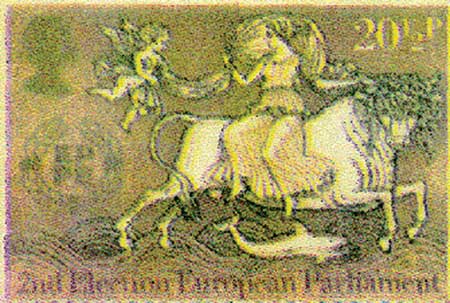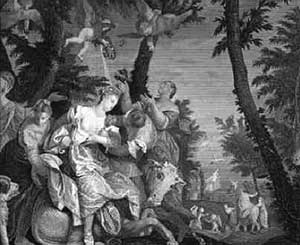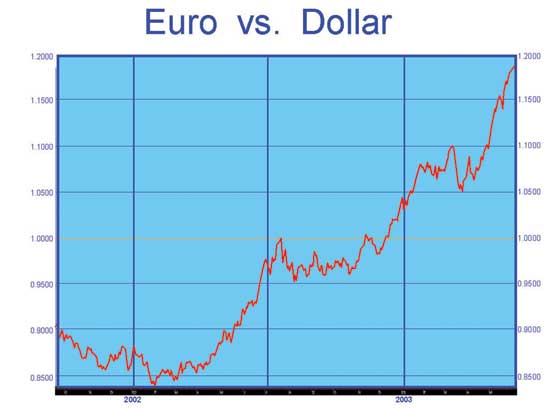In our previous articles we reviewed some of the reasons Bible scholars have been anticipating a "Revived Roman Empire" as part of the prelude to the "Last Days." Just as Daniel had predicted,1 the Babylonian Empire was ultimately conquered by the Persians; the Persians were, in turn, conquered by the Greeks; and, the Greeks were conquered by the Romans. But no one conquered the Romans. The ensuing struggles for power, and the influx of external tribes into the cohesion that once was Rome, went on for almost two millennia.
Post-War Europe
Continuing the historical summary of our previous articles, by the end of World War II Germany was dramatically reduced in size and divided into East and West. The USSR gained Estonia, Latvia, Lithuania and Ukraine and occupied northern East Prussia, including Knigsburg (Kaliningrad). Much of Eastern Europe effectively became an extension of a massively expanded Soviet Empire. The Soviet Bloc also created a buffer zone between the USSR and the rest of Western Europe.
Relations between the West and the Soviet Union were plunged into the freeze known as "The Cold War." In April 1949, the North Atlantic Treaty Organization (NATO) was formed by 10 Western European states, the U.S. and Canada to provide a military framework for cooperation in the face of what was seen as a common enemy.
The Treaty of Paris
The war had left Europe scarred with deep ruins and despair. Many leaders realized that they could never let that happen again. However, numerous attempts at alliances and treaties were attempted but failed. The roots of the remaining tensions ran too deep. A few visionaries, recognizing that these direct attempts were doomed to failure, determined that the only viable path would be to first "unite" Europe economically, and the best place to start was in the heavy industries: coal and steel. To accomplish this, in 1951 the Treaty of Paris created an innovative organization: the European Coal and Steel Community (ECSC). It was signed by six countries: German, France, Italy, and the three "BeNeLux" countries, Belgium, Netherlands, and Luxemburg. It created a multinational "Commission" to centrally manage the coal and steel industries of the six countries. It proved so successful that it became the model for the treaties that were to follow.
The Treaties of Rome
In March 1957, to take effect January 1, 1958, these same six nations signed the Treaties of Rome, which created two more multinational consortiums: The European Atomic Energy Community (EAEC) and the European Economic Community (EEC). The astonishingly ambitious goal of the EEC was to build a unified tariff wall around the six signatories and remove the tariffs among them. This sounds simple, but it was widely regarded as fanciful and ultimately doomed to failure. However, much to the amazement of many international observers, it accomplished the objectives for its initial phases two years ahead of schedule!
 A European Parliament was formed, but I can remember those early years when most people didn't even realize it existed, and few took it seriously. The symbol of the European Parliament is a woman riding a beast atop seven hills. This is a representation from classic Greek mythology of an affair between the Greek god Zeus and the legendary beauty Europa. Zeus spotted and fell in love with the young princess as she picked flowers. He changed himself into a handsome bull and carried her off to the island of Crete, where she bore him three sons. In 1580, the Italian artist Paolo Veronese rendered this tale into a his classic painting, The Rape of Europa. The European continent may have originally been named after Europa: the official Internet site of the European Union is https://europa.eu.int/. (To Bible students, the woman riding the beast is suggestive of Revelation 17, indeed!)
A European Parliament was formed, but I can remember those early years when most people didn't even realize it existed, and few took it seriously. The symbol of the European Parliament is a woman riding a beast atop seven hills. This is a representation from classic Greek mythology of an affair between the Greek god Zeus and the legendary beauty Europa. Zeus spotted and fell in love with the young princess as she picked flowers. He changed himself into a handsome bull and carried her off to the island of Crete, where she bore him three sons. In 1580, the Italian artist Paolo Veronese rendered this tale into a his classic painting, The Rape of Europa. The European continent may have originally been named after Europa: the official Internet site of the European Union is https://europa.eu.int/. (To Bible students, the woman riding the beast is suggestive of Revelation 17, indeed!)

The European Community Is Born
The three multinational organizations - the ECSC, the EAEC, and the EEC (commonly known as the "Common Market") - each had its executive functions vested in its respective "Commission," each reporting to the composite Council of Ministers of the six signatory countries. In 1967, these three Commissions were simply merged into a single Commission, creating what was then called The European Community (EC).
In 1973, the United Kingdom, Ireland, and Denmark joined the Community. In 1981, Greece joined, making the total number of countries 10. (Many Bible students became particularly intrigued now, recalling the "ten toes" of Daniel 2, and the "ten horns" of Daniel 7 and Revelation 13, etc. Our enthusiasms were a bit premature; we all had more homework to do.)
In 1986 Spain and Portugal joined, making it 12, which seemed to puncture some of our presuppositions!
The Maastricht Treaty
In June 1993, a milestone treaty was signed in the city of Maastricht, Netherlands, that would obsolete the Treaty of Rome: it established the goals of a common currency, a common judiciary, a common foreign policy, and a common military. What emerged is now known as the European Union (EU).
In November 1993, I had the opportunity to interview 40 of the top leaders in nine cities of the countries involved. Traveling with Ambassador William Middendorf,2 it became quite evident that the behind-the-scenes machinations to finesse the votes within each country to approve the Maastricht Treaty were highly organized by the international socialists and other proponents.
The Enlargement Continues
In 1995, Austria, Finland and Sweden joined the European Union. To solidify the requirements a candidate needs to become eligible to join the European Union, the "Copenhagen Criteria" was established. The criteria included: stability of institutions guaranteeing democracy, the rule of law, human rights, and respect for and protection of minorities; a functioning market economy as well as the capacity to cope with the competitive pressure and market forces within the Union; and, adherence to the political, economic and monetary aims of the Union. In the decade of the 90s, the EU has spent more than $85 billion on pre-accession aid to the countries of Central and Eastern Europe. This is about as much in real terms as the American Marshall Plan in the immediate aftermath of WWII.
This was not just to put the economies of these countries back on their feet. It was also to help them build up democratic institutions, to encourage the development of civil society, to train administrations in which the concept of public service is strong enough to overcome the temptation of corruption, and to help to build judicial systems that citizens believe are independent and able to ensure that the rule of law holds sway in practice and not just in theory.
A Common Currency
The ancient Romans started using coins in about 290 B.C., steadily expanding their use from their native Italian homeland, and as they conquered remote territories, their coinage - and language - went with them. By the 1st century A.D., their denarius, sestertius, and aureus were the common currency throughout Europe, the Mediterranean and the Middle East, from Scotland to the Sahara, from Portugal to Iran. At a time when it could take two months to travel from London to Rome, this symbol of centralized authority was a powerful force for fiscal cohesion. (In the 3rd century, Emperor Caracalla is said to have ordered the entire population of Thrace - roughly modern Bulgaria - to be sold into slavery for refusing to use the standard Roman coinage!)
The subsequent history of attempts at monetary union is spotty. In the 8th century - 300 years after the collapse of the western leg of the original Roman Empire - Charlemagne, King of the Franks, imposed a uniform system of silver coinage on the lands under his control: roughly equivalent to France, Germany, Italy, Belgium, Holland and Luxembourg. In the 9th century, Danegeld, a tribute paid by terrified communities across Europe to prevent attacks by marauding Vikings, can be viewed as a rudimentary form of monetary union.
Napoleon toyed with the idea of a uniform European currency without significant results. The Latin Monetary Union (1865-1926) and the Scandinavian Monetary Union (1873-1924) were early but unsuccessful attempts at European monetary integration.
 However, before the millennium closed, an historic milestone was put in place: the European Monetary Union (EMU). The final stage of the EMU began on January 1, 1999, when the exchange rates of the participating currencies were irrevocably set. Twelve member states introduced the new euro banknotes and coins at the beginning of 2002. (Denmark, Sweden and the United Kingdom are members of the European Union but are not yet participating in the single currency. Denmark is a member of the Exchange Rate Mechanism II (ERM II), which means that the Danish krone is linked to the euro, although the exchange rate is not fixed.)
However, before the millennium closed, an historic milestone was put in place: the European Monetary Union (EMU). The final stage of the EMU began on January 1, 1999, when the exchange rates of the participating currencies were irrevocably set. Twelve member states introduced the new euro banknotes and coins at the beginning of 2002. (Denmark, Sweden and the United Kingdom are members of the European Union but are not yet participating in the single currency. Denmark is a member of the Exchange Rate Mechanism II (ERM II), which means that the Danish krone is linked to the euro, although the exchange rate is not fixed.)
The European Central Bank has been quietly stockpiling gold and is apparently pursuing a strategy of making the euro an asset-based currency (in contrast to the U.S. dollar, which is debt based). The implications of these maneuvers will be explored in our next article.
A Central Assisting Partner
The EU has become the dominant trading partner of 13 candidate countries. As a result of the Nice European Council (December 2000), direct EU investment has exceeded 67% of foreign investment into the candidate countries of Central and Eastern Europe. Over the past six years, the total value of trade has increased threefold to 210 billion/year.
EU member states run considerable surpluses on their export trade with candidate countries, which result in more jobs, more tax revenue and more money for social security systems: over 25.8 billion/year. (In contrast, the U.S. will book a record deficit of over $435 billion this year!)
The direct financial assistance to EU candidate countries is being provided through three primary instruments: Phare, ISPA, and Sapard. The Phare budget is 1,620 million for institution building: structures, strategies, human resources, and management skills needed to strengthen their economic, social, regulatory and administrative capacities. This includes financing for regulatory infrastructure to ensure compliance in areas such as food safety, making frontiers secure, testing and measuring equipment related to consumer protection, etc., and financing to promote a market economy to cope with competitive pressures within the EU when they qualify to join.
ISPA (Instrument for Structural Policies for Pre-Accession) has a budget of 7 billion (2000-2006) for environmental infrastructure assistance concentrated on drinking water, wastewater treatment, solid-waste management, and air pollution.
Sapard has a budget of 540 million/year to prepare for the Common Agricultural Policy and the Single Market. The key point here is that the EU itself is financing and assisting the candidate countries to qualify themselves for membership.
The Candidates
There are ten countries that are going to join the European Union in 2004: the Central European states include Poland, Hungary, Czech Republic, Slovakia, and Slovenia. The Baltic States include Estonia, Latvia, and Lithuania. And there are also two Mediterranean island republics: Cyprus and Malta.
There are also two candidates scheduled to join in 2007: Bulgaria and Romania, which will bring the total to 27. This would bring the total population of the European Union to 446 million, almost 70% larger than the United States.
This still does not count the enigma of Turkey, which has been pursuing membership since 1987 but is not likely to be resolved soon. The geopolitical (and Biblical) implications of Turkey's situation will be reviewed in a subsequent article.
In our next article we will summarize the rather surprising implications of the rising European empire and the portents on the horizon for the United States and the world community.
Notes:
- Daniel Chapter 2 and 7.
- Ambassador to the EU, the Netherlands, OAS, and former Secretary of the Navy.





